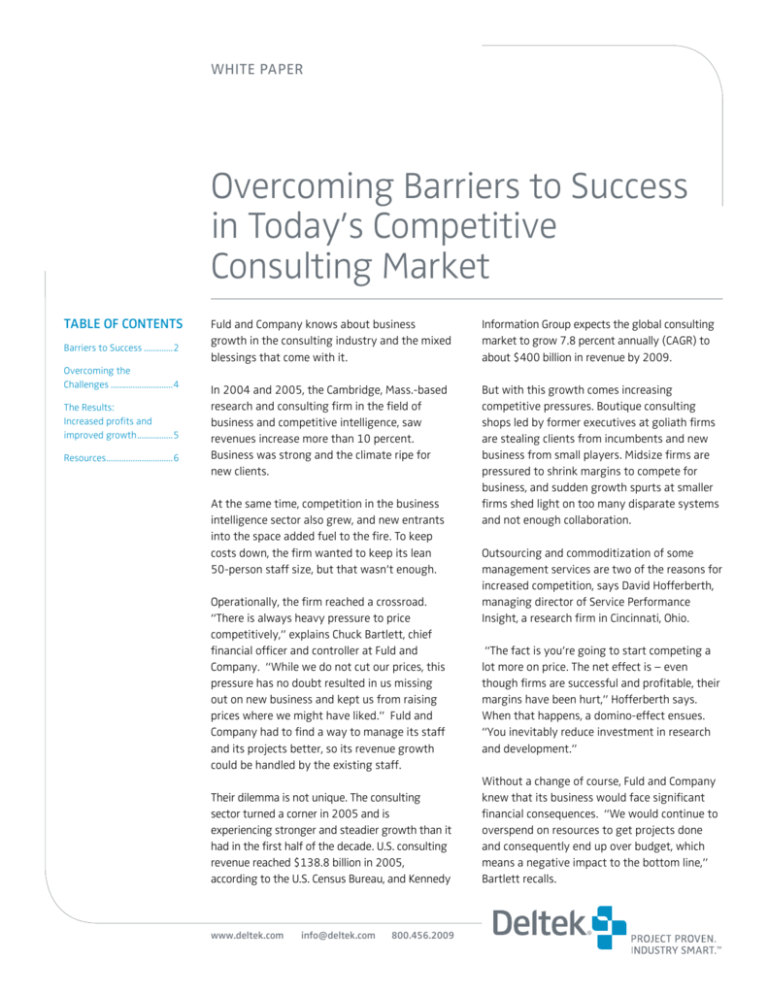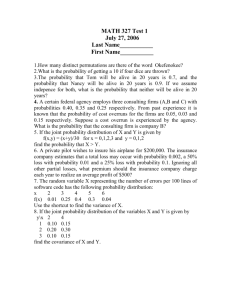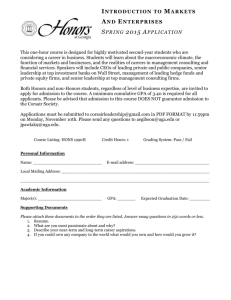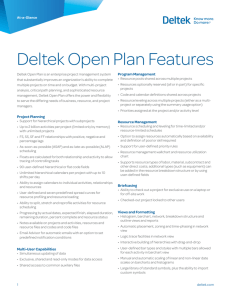
WHITE PAPER
Overcoming Barriers to Success
in Today’s Competitive
Consulting Market
Table of Contents
Barriers to Success..............2
Overcoming the
Challenges.............................4
The Results:
Increased profits and
improved growth.................5
Resources...............................6
Fuld and Company knows about business
growth in the consulting industry and the mixed
blessings that come with it.
Information Group expects the global consulting
market to grow 7.8 percent annually (CAGR) to
about $400 billion in revenue by 2009.
In 2004 and 2005, the Cambridge, Mass.-based
research and consulting firm in the field of
business and competitive intelligence, saw
revenues increase more than 10 percent.
Business was strong and the climate ripe for
new clients.
But with this growth comes increasing
competitive pressures. Boutique consulting
shops led by former executives at goliath firms
are stealing clients from incumbents and new
business from small players. Midsize firms are
pressured to shrink margins to compete for
business, and sudden growth spurts at smaller
firms shed light on too many disparate systems
and not enough collaboration.
At the same time, competition in the business
intelligence sector also grew, and new entrants
into the space added fuel to the fire. To keep
costs down, the firm wanted to keep its lean
50-person staff size, but that wasn’t enough.
Operationally, the firm reached a crossroad.
“There is always heavy pressure to price
competitively,” explains Chuck Bartlett, chief
financial officer and controller at Fuld and
Company. “While we do not cut our prices, this
pressure has no doubt resulted in us missing
out on new business and kept us from raising
prices where we might have liked.” Fuld and
Company had to find a way to manage its staff
and its projects better, so its revenue growth
could be handled by the existing staff.
Their dilemma is not unique. The consulting
sector turned a corner in 2005 and is
experiencing stronger and steadier growth than it
had in the first half of the decade. U.S. consulting
revenue reached $138.8 billion in 2005,
according to the U.S. Census Bureau, and Kennedy
www.deltek.com
info@deltek.com
800.456.2009
Outsourcing and commoditization of some
management services are two of the reasons for
increased competition, says David Hofferberth,
managing director of Service Performance
Insight, a research firm in Cincinnati, Ohio.
“The fact is you’re going to start competing a
lot more on price. The net effect is – even
though firms are successful and profitable, their
margins have been hurt,” Hofferberth says.
When that happens, a domino-effect ensues.
“You inevitably reduce investment in research
and development.”
Without a change of course, Fuld and Company
knew that its business would face significant
financial consequences. “We would continue to
overspend on resources to get projects done
and consequently end up over budget, which
means a negative impact to the bottom line,”
Bartlett recalls.
“Eventually, we would reach the size where you
couldn’t really fix the problem by simply saying
‘stop it.’ We needed something more
systematic and procedural to make it work
across the whole firm,” he adds. “When you’re
smaller you can get together in a room and
solve procedure problems. We were beyond
that.”
The firm was able to overcome these challenges
by identifying its operational weak points and
adopting new business methodologies and a
centralized project management system.
Like Fuld and Company, consulting firms can
manage these competitive pressures if they
recognize barriers that keep them from
achieving growth and profitability. Experts
have identified the top five barriers to achieving
profitability and growth in the consulting
market, and offer tips for success.
Barriers to Success
Firms that don’t
effectively plan
for future resource
needs at least 10
months down the
road risk losing
business.
1. Balancing Growth And Profitability
The dot-com bust and the breakup of the Big
Five consulting firms from 2001 to 2003 left
the consulting industry gun-shy about investing
in growth, especially in small to mid-size firms
with revenues less then $1 billion, Hofferberth
says. Today, the mantra has shifted from
survive to thrive. Firms are growing, their clients
are growing, and those clients are demanding
more services. But some firms have forgotten
the importance of investing in research and
development.
“R&D is the lifeblood of future growth for any
organization,” Hofferberth says.
But how do you balance the investments you’re
making to grow with your profitability? “Firms
are having a hard time identifying and overseeing
profitable projects and resources in their firms,”
says Scott DeFusco, vice president of product
management at enterprise management
software developer Deltek Systems Inc. in
Herndon, Va. “The challenge is figuring out what
WHITE PAPER: The Necessity of a Collaboration Tool in Today’s Projects
are the most profitable projects, the most
profitable markets, and which people are driving
the profitability in the firm.”
Some firms also have difficulty forecasting and
balancing their resource needs. Firms that don’t
effectively plan for future resource needs at
least 10 months down the road risk
losing business.
2. Managing Operational Growing Pains
Small and mid-market firms are expanding into
new markets, opening new offices, and
watching revenues climb like never before. In
fact, three U.S. consulting firms crossed the $1
billion threshold in consulting revenue in 2005,
according to Kennedy Information.
But as they grow, many firms begin to realize
that they’re not being efficient when it comes
to allocating resources. A few disparate sales
management and project management systems
suddenly become dozens, departments become
silos of information that can’t communicate
with one another, and paper processes become
enormous, which make the organization
inefficient. This leads to a breakdown in
collaboration, which is vital to continued
business growth.
Optimation Technology, an engineering,
automation and information systems firm
based in Rochester, N.Y., has increased its
employee size by 50 percent in two years and
seen a 40 percent increase in annual revenues
year over year. Until the early 2000s, years of
using five separate external databases to track
employees, projects and clients were creating
inefficiencies in Optimation’s business
processes, not to mention wasting several man
hours a month.
There were also other limitations in their ability
to track projects, utilize resources and client
contacts. “We had been using (client contact
management software), but were never able to
tie it back to any of our specific projects,”
explains CFO Kelly Burns. “It’s easy to lose a lot
of valuable information that way.” What’s
more, “because the systems were not
integrated, people could manage and plan at
the task level, but only using offline programs.
This prevented upper management from
knowing what the whole company was doing in
terms of utilization.”
3. Improving Customer & Employee
Satisfaction
As firms grow quickly, they can become so
focused on new clients that they forget about
the old clients that got them where they are
today. “One of the biggest challenges in growth
mode is making sure you don’t disconnect with
your clients,” DeFusco says.
What’s more, clients want work done faster and
cheaper, Hofferberth says. “The fact is you have
to have the resources available to do the work
faster.”
At Deltek’s annual
client conference,
some 1,200
consultants reported
they were most
concerned with
maintaining and
attracting talent
to meet project
demands.
Customers also grow dissatisfied when firms
misalign clients with project teams. “As firms
are growing they’re becoming less and less
knowledgeable about the talent pool,” DeFusco
says. “If we’re doing a project with a large
financial services firm, there may be someone
on our staff who came from that company –
and we need to know about it.”
Internally, firms are challenged to keep
consultants happy by assigning them to projects
that they want to do in desirable locations. “If
they’re excited about what they’re doing, they do
a better job for the client,” he adds.
Firms are also challenged to keep customers
happy by billing them correctly.
When Triton Services Inc., a Bowie, Md.-based
provider of advanced IT solutions and services
to the public and private sector, was a small,
20-person firm in the early 1990s, manual data
entry and checking for data accuracy were
manageable processes. But by the late 90’s, the
company began to grow steadily, spurred on by
entry into the world of prime federal
WHITE PAPER: The Necessity of a Collaboration Tool in Today’s Projects
contracting. Soon Triton discovered its software
for small, routine accounting procedures wasn’t
enough anymore.
“Payroll had to be done on the side and posted
manually. Also, the system was unable to
handle job costing, labor distribution, billing or
timekeeping,” says Controller Susie Griffin. “As
a result, our data integrity was always in
question, and we had to manually calculate bills
and rates – an inefficient process that took time
and manpower.”
4. Increased Competition
The largest firms have seen some of their top
executives leave to start boutique shops –
taking some talented co-workers with
impressive resumes with them. Not only does
the departure sting the big players, but it has
also created fierce competition in the small- to
mid-sized market – not just for new business,
but for attracting and keeping talented staff.
At Deltek’s annual client conference, some
1,200 consultants reported they were most
concerned with maintaining and attracting
talent to meet project demands.
In fact, 47 percent of IT professionals reported
that they were actively or passively looking for
another job, according to a 2006 survey of
nearly 15,000 IT workers, including consultants,
by Computerworld. Almost two-thirds of those
job-seekers say they’re looking for higher pay.
Some 47% were seeking better career
opportunities, and 43% wanted more
interesting or more challenging work.
“One company had 100 people, and they were
looking to grow to about 260 because they
literally had that much work in the pipeline,”
DeFusco explains. “They can’t find enough
talent to handle the workload.” They’re also
faced with retaining the talent they already
have by keeping employees well compensated
and excited about what they’re doing; as well as
providing an upwardly mobile work
environment.
Increased competition also affects billing rates.
Firms are being forced to keep rates competitive,
so those that are lean and efficient can continue
to grow and innovate despite smaller profit
margins. Consider the troubled airline industry.
The carriers that can balance efficiency with the
right destinations while keeping rates down are
not only surviving, but thriving.
5. Managing Risk
Putting too many resources into one client or
project can have a devastating effect on small
but growing consulting firms. A 75-person
consulting firm who specialized in government
work recently lost a major government contract
and had to layoff half of its staff because it
represented a large chunk of its business. “Firms
really struggle to see the risks in enough time to
mitigate them,” DeFusco says.
Firms that don’t
effectively plan
for future resource
needs at least 10
months down the
road risk losing
business.
Firms need to look at the entire portfolio of
projects they are currently managing within the
organization. Any metrics that firms are tied to
through their strategic planning or corporate
budgeting process has a risk. “If you’re not
tracking how you’re doing on a day-to-day or
week-to-week basis, you’re not going to be able
to mitigate those risks,” he adds.
Custom software and IT services firm Automation
Creations Inc. in Blacksburg, Va., faced a growing
client roster and internal growth that nearly
doubled the firm size in 18 months.
But as it grew, it was losing site of its risks. The
firm was still using an outside accountant for
basic accounting and payroll functions. This left
ACI limited to high-level reporting. “We
sometimes had to wait for up to six months for
quarter-end financial reports using our outside
accountant,” says CFO Rob Stuart. “It was clear
that we needed an in-house program that we
could have up and running quickly to give us
more accurate and reliable data in a more timely
fashion. Otherwise, without the appropriate
fiscal data, we couldn’t make timely business
decisions on any of our projects.”
Overcoming the Challenges
After careful analysis, Fuld and Company
realized that it could keep rates competitive,
improve margins and gain revenue through
more efficient processes and technology.
“It all comes down to better project
management for us. That’s true industry-wide
for companies of our size,” Bartlett explains.
“We were doing project management in more of
a traditional, old-school kind of way – ad hoc,
with very inconsistent processes, procedures,
systems and tools. Each individual manager
might have their own way of doing project
management. It was hard to control time and
expenses and the margin we were getting out
of it.”
Fuld deployed a single, companywide project
management software solution to streamline
processes. The solution allowed project
managers to see the resources, time and
expenses of each project on a regular basis.
Experts recommend the following steps to
overcome growing pains.
Innovate
Some two-thirds of global business leaders
expect to drive fundamental changes within
their organization in the next two years, a
process they see as an opportunity to expand
their “innovation horizon,” according to a 2006
global study of 765 CEOs and business
executives conducted by IBM Business
Consulting Services. Most of them will use
technology as an innovation catalyst by
combining it with business and market insights.
“Growth – perhaps even survival – depends on
innovation,” the study says.
The same philosophy holds true in the
consulting industry. Those who innovate and
differentiate their firm from their competitors
will grow.
Business model innovation was also important
to these CEOs. Competitive pressures have
WHITE PAPER: Overcoming Barriers to Success in Today’s Competitive Consulting Market
pushed business model innovation much higher
than expected on CEOs’ priority lists. But its
importance does not negate the need to focus
on products, services, markets and operational
innovation, according to the study. But
innovation requires orchestration from the top,
the study cautions. “CEOs acknowledge that
they have primary responsibility for fostering
innovation. But to effectively orchestrate it,
CEOs will need to create a more team-based
environment, reward individual innovators and
better integrate business and technology.”
Look at the big picture
Most growing consulting firms haven’t mapped
out their entire business cycle and all of the
tools they need to support those processes,
DeFusco says.
At Deltek’s annual
client conference,
some 1,200
consultants reported
they were most
concerned with
maintaining and
attracting talent
to meet project
demands.
The typical project delivery cycle includes
marketing, surfacing opportunities, identifying
jobs to pursue, submitting a proposal, building
the client relationship, and winning the work.
Then firms execute the project, manage
resources, collect time and expenses from
employees, bill the client, and processing
payroll. But one important step is missing. “At
the end of that project, you need to track your
performance to see ‘What can I do better the
next time? Where did we go off-track, and
where were we on-track?’” DeFusco advises.
While individual managers may indeed track
performance, it is often done on disparate
spreadsheets and marketing systems. Client
contact information may be kept in another
system. Billing rates are kept in yet another
system. Client information may vary in each
system. For instance, Acme Supply Company
could be listed by its full name in one system,
and ASC in another system. “By the time you
map it out, you have a very disturbing picture,”
DeFusco says. With disparate systems, “you
don’t have that one version of the truth. When
you do that, people lose faith in the information
and they turn away from it,” he adds.
Industry-watchers advise firms to look at their
processes and think of them in a whollyintegrated view, preferably through a single
software solution that integrates the entire
business cycle.
Identify and mitigate risks
Firms should adopt an automated, dashboard
view of all projects in progress and their impact
on the firm’s bottom line. For instance, each
project should be represented with a square.
The size of square represents the size of project
being managed. The color of box should
represent the health of the project. Bright red,
for instance, means the project is beginning to
veer off course, off schedule, or profitability is
dipping based upon current expenditures.
Resource utilization should also be tracked in
this manner.
At Automation Creations, the firm integrated an
accounting module throughout the enterprise
that specifically meets the needs of projectbased business and professional services firms.
“Being able to know where we are financially,
from anywhere, is a godsend,” Stuart says. The
software also has the ability to track the
number of billable hours ACI employees are
logging. This helps Stuart and other ACI
executives compare hours expended versus
hours forecast on any project in ACI’s pipeline,
helping to keep them on budget and on time.
Equip all staff with the most efficient
tools
Sure, project managers and payroll
administrators can speed through an Excel
spreadsheet and crunch the numbers like
there’s no tomorrow, but there is an
underserved group of critical number-holders
who also need more efficient tools. The highly
valuable, but never-in-the-office traveling
consultants can slow down project management
efficiency.
These travelers carry days or weeks worth of
receipts and mental notes of time expenditures
during their travel. When they return, they
WHITE PAPER: Overcoming Barriers to Success in Today’s Competitive Consulting Market
often spend two to three hours of
administrative time trying to recall their
expense. “Invariably there’s a 3 percent to 5
percent rate of inaccuracy with that,” DeFusco
says. What’s more, administrators waste
additional time making corrections to time and
expense reports once the errors are discovered,
which slows the process further.
Firms need to make consultants more efficient
when they’re traveling and empower them with
technology that allows them to be efficient on
the road. They can’t feel disconnected from
their systems when they’re on the road. They
can’t feel that they need Web access.
A wireless PDA can be equipped with time and
expense reporting software that is accessible
online or offline to help consultants keep up
with their administrative tasks – whether in a
taxi, an airport or on a plane.
Firms that don’t
effectively plan
for future resource
needs at least 10
months down the
road risk losing
business.
Monitor and track employees’
experience and preferences
Firms should try to align each employee’s career
goals with project goals. By keeping track of
employees’ preferences for projects and work
locations, firms can make more successful
project team matches and retain employees at a
higher rate.
At Fuld and Company, project managers can
track its small staff easily, “But because we use a
lot of contractors, we could benefit from using
resource management software,” Bartlett says.
The Results:
Increased profits and improved
growth
Consulting firms that automating project
management, resource management and
portfolio management functions can realize
significant savings and efficiencies, according to
industry researchers.
25 percent profit increase, according to author
Thomas Lah in his book, “Building Professional
Services.”
Optimation Technologies decided to replace their
multiple databases with a single, fully integrated
product offering project management, resource
planning, financial and project accounting,
customer relationship management, billing,
timekeeping and employee expense. The Webbased system created a smoother workflow
within the company and made it easier for
traveling or remote employees to access the most
up-to-date project information. “Better still,
because it’s Web-enabled, all our multiple
branches can conform to that same standard,
making quality control much less of an issue,”
Burns says.
What’s more, “the system intuitively maintains
the history of every single project we’ve ever
worked on,” adds President William Pollock,
allowing executives to stay completely informed
on each project. By streamlining its financial
system, Optimation saved at least $75,000 a
year on additional staffing costs, Pollack adds.
Likewise, when firms automate the tracking of
its resources, utilization increases by 8 percent,
according to research by Aberdeen Group in
Boston. What’s more, employees who aren’t
overused don’t suffer from burnout. “When you
can balance your utilization by choosing
available employees with the right type of skills
for the project, you’re able to retain employees,”
DeFusco says.
When a consultant is over-utilized, he or she
represents a general risk for the group because
their departure would be devastating.
At Triton Services, labor distribution software
was integrated with the firm’s homegrown
timekeeping system, significantly decreasing
the number of manual data errors as well as
time spent on processing labor data.
By adopting a standard method for project
management, firms can realize a 10 percent to
WHITE PAPER: Overcoming Barriers to Success in Today’s Competitive Consulting Market
At Deltek’s annual
client conference,
some 1,200
consultants reported
they were most
concerned with
maintaining and
attracting talent
to meet project
demands.
“Because of this integration, labor distribution
now takes only four hours compared to the
exhausting two and a half days it previously
took,” Griffin says. “We’ve been able to reduce
time spent and improve the data accuracy of
these processes by about 95 percent.”
Resources
Invoice cycle can be reduced by 33 percent
when firms use a centralized project
management solution, according to an
Aberdeen study. Imagine a firm with a paper
timesheet process where employees have to
track time on the road, fill out a paper time
sheet and expense report, clip receipts, and do
copying and scanning. By the time the
information is fed into the cycle it could be
weeks to a month later before that invoice gets
out the door.
3 Park Avenue, Fl. 30 • New York, NY 10016 USA
Tel: 212.563.6054 • Fax: 212.563.6138
“Overcoming Barriers to Success in Today’s
Competitive Consulting Market”
Published by KENNEDY INFORMATION
Consulting Magazine Custom Media
Automated systems can significantly reduce
those delays with the use of mobile
applications, Web access, alerts that remind
employees to get in their time and expense
reports, and alerts that go to their managers if
they don’t submit those reports. These steps
decrease the invoice cycle and get bills out more
quickly. Likewise, more money goes more
quickly back into the company to invest.
Today, almost a year after revamping its project
management procedures, Fuld and Company
sees a trend toward on-budget projects.
Bartlett is able to capture information quickly
and easily for his weekly project management
reports and monthly financial analysis reports.
“The information flow is much faster. I’m able to
see what time people are putting in
immediately, and its cumulative affect,” Bartlett
says. Some employees still lag in reporting their
time and expenses, and there may still be some
delays. But overall, “because that’s all
happening in one system, I’m able to bring up
financials and the closed months to get out the
actual financial reporting and analysis to
management much more quickly.”
WHITE PAPER: Overcoming Barriers to Success in Today’s Competitive Consulting Market
Contact
Deltek
www.deltek.com
info@deltek.com
800.456.2009
Deltek is a global leader dedicated to delivering enterprise management software that meets the unique
needs of project-focused organizations. With over two decades of experience, Deltek enables companies to
maximize profitability and productivity, integrating all aspects of their businesses. More than 11,000
customers worldwide rely on Deltek to streamline operations, improve performance and win more business.
Deltek • 13880 Dulles Corner Lane, Herndon, VA 20171
US & Canada: 800.456.2009 or 703.734.8606 UK +44 (0) 20 7518-5010
© 2007 Deltek, Inc. All rights reserved. All referenced trademarks are the property of their respective owners.










